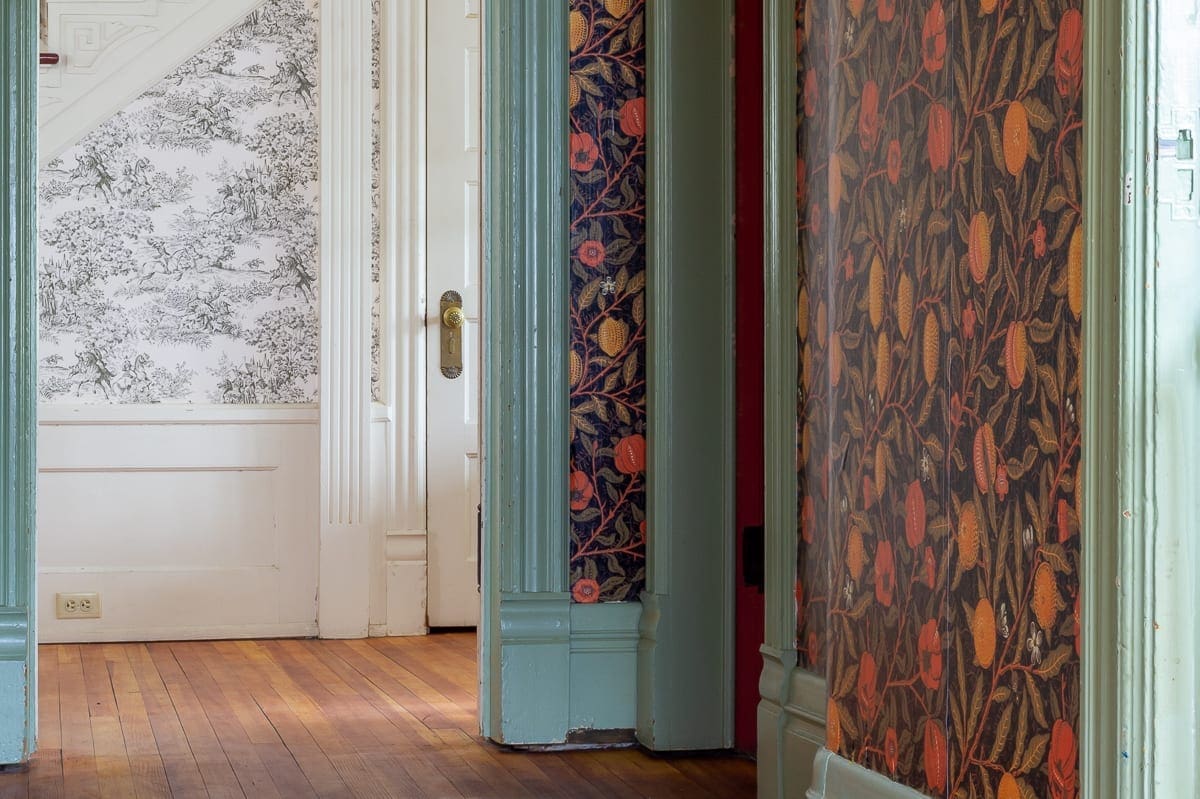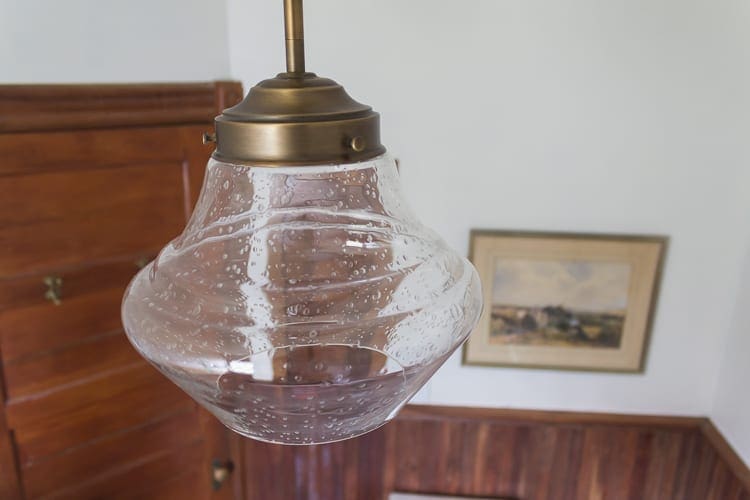Thank you for being excited about the front entry makeover that I announced last week. In case you missed it, Spoonflower is generously sponsoring the wallpaper portion of this project, and I am still pinching myself. After three long workdays, the room looks so different that it feels like we moved! Installing the Spoonflower wallpaper made all the difference.
This post is sponsored by Spoonflower. All opinions are my own.

Installing Spoonflower wallpaper was a little different from my past experiences, but it was also the most straightforward. The major difference I noticed was that the straight repeat and overlapping seams made matching the pattern a breeze.
Since there is already a helpful set of installation instructions with videos on the Spoonflower website, consider this post a companion guide. Start there for the basics, and I’ll cover the tips and tricks I learned this time around.
Wall Prep
Overall, the walls were in great shape. However, I did do two quick repairs. First, I scraped loose paint and skim-coated above the exterior door.


Then, I tidied up where the plaster meets the baseboard, by cutting off paint blobs (technical term!) and sanding the edges smooth with my handy detail sanding sticks. Over the years, paint drips accumulate, and I removed the build-up to ensure a sharp line between the wallpaper and the baseboards.


Lastly, I removed the crown molding because it is not original, and I plan to replace it. I’ll address that portion of this project in a future post.
Important Note: It is much better to paint or strip the baseboards before wallpapering. However, I am still not sure what I want to do with ours. That is why I scheduled the project in this order.
The First Piece
It is no lie that wallpapering is a partner project, but sometimes we have to do whatever it takes. Andy and I worked as a team for part of the time, and I hung some of the pieces alone too. For the first-timer, I do not recommend working solo. It is not worth the frustration.
Spoonflower recommends starting in a corner. Unfortunately, the only full corners in this room are super tight and include intricate cuts around the wood trim or stairs. Since I do not install wallpaper regularly, I decided it would be better if I started somewhere with easier cuts to adjust to the project.
I opted to start on the right side of the exterior door and wallpaper over to the left side of the back staircase. Then, instead of picking up on the other side of the back staircase, I went back to my starting point and worked my way around in the opposite direction, terminating on the right side of the stairs. By installing the paper in this order, I did not have to match the pattern of the starting piece with the ending piece. I had 99 problems, but that wasn’t one of them.
Since almost no house is perfectly square, and certainly not an old one, I measured out 24 inches (the width of my wallpaper) from my starting point and drew a vertical line using my level.


I hung the first piece flush with the plumb line, and we were good to go.

On an accent wall or in a tiny space such as a powder room, a plumb line may not be necessary. Just keep in mind that if the pattern is slightly off vertically, it will keep listing more and more as you add each new piece. That’s why I recommend a marking level line for the first piece. It’s a quick step that will save you a headache later.
Installing Spoonflower Wallpaper: Working Around Obstacles
First, I don’t think I could have chosen a more complicated room. In this hall, there are seven door openings with fancy trim, one cabinet with the same trim, two curved walls, two light switches, one sconce, and a doorbell!

Curved Walls
The basic wallpapering instructions state to thoroughly wet the paper, book the piece (fold the edges to the middle), and set it aside for 3-5 minutes to activate the adhesive.

Then, the procedure is to start from the top smoothing the piece down towards the baseboard. However, we discovered that method did not work well with the curved wall. Instead of getting smoother, the paper started to crease and bubble at the edges because we could not smooth it evenly down and around the curve simultaneously. We solved the problem by lining up the pattern at the seam and working over to the curve. Painter’s tape kept the seam from slipping out of place.

Then, we smoothed it around the curve as a second step and finished with the remainder of the flat wall. To help the bottom edge ease around the curved baseboard, I made small cuts in the paper.


Take a look at those curves!

I apologize for the weird lighting in these photos. We ran out of daylight.
Tight Corners and Woodwork
The original instructions say to wait until the wallpaper is dry before trimming around the woodwork. However, that is extremely difficult in tight corners where the extra paper bunches up. The idea behind waiting is that the paper shifts around when it is wet, making it easier to make cutting errors. Also, wallpaper may shrink a little when it dries, which could make it pull away slightly and expose the wall behind.

Instead of waiting, I used an extra sharp blade to tidy the left side immediately. Then, I pushed the paper firmly into the corner and trimmed off the right side.


These cuts take time and patience. From top to bottom, this piece took about an hour. Wallpapering is not a quick job.
The stairs were another problem area. I had to cut immediately rather than wait.


None of this is perfect, but a little dab of a colored marker on the plaster will make the errors disappear. Painting the trim first and bringing the color slightly past the woodwork would solve the problem another way.

Light Switches and Other Obstacles
I removed everything possible first–faceplates, the smoke detector and mounting bracket, the glass chimney from the sconce, and the doorbell cover. After that, the method was the same.
I smoothed the paper from the top down until I could feel the obstacle with my thumb.

I made a small slit with my utility knife.

Continuing to smooth the paper, I cut the rest of the hole carefully, making sure my metal blade did not touch an electrical connection. The best course of action is to shut off the breaker first.

Be careful not to cut away more than a faceplate will cover.

Installing Spoonflower Wallpaper – Solving a Puzzle
During day two we ran into our first snag. For the first couple of hours, I worked alone. When Andy came home to help, he counted the paper we had left, did a few calculations, and determined that we were short two rolls. How could that be? I was so careful to order enough this time because I ran short during the bathroom project. This time, I was hesitant to add rolls to my large order, so I guess I just cut it too close.
“Franken-papering”
By this time, our scrap pile was getting large, so we put our heads together to solve the problem. It took a long time, but we determined that if we did a little “franken-papering” behind the kitchen door, we could make up the difference and end with exactly the right amount–no room for error.
It reminded me of a time in California when I woke up one morning and realized that I only had one match left to start the wood stove that heated our entire house. Guess who made a roaring fire that day?
Not enough wallpaper? Challenge accepted.
Behind the door, I carefully lined up the pattern using scraps. In the last post, I said that horizontal seams aren’t a thing in wallpapering, but they are in “franken-papering.” The key is to hide them well. I recommend positioning the overlap away from the light source and eye level. We worked so hard at this that it nearly broke my brain. It was worth it. The patches do not show in photos, and I dare anyone to come over and find them in person. That last sentence came across more aggressive than I intended.

Fudging the Pattern
Wallpapering the hall was a challenging project, and we had to make some sacrifices with matching now and then. Luckily the busy pattern hid everything, making it the perfect choice for this complicated room. When we ran into a pattern snag, we tried our best to conceal the issue somewhere inconspicuously. Dark corners and over doors made excellent hiding places.
After we pieced the paper behind the kitchen door, we had exactly enough wallpaper rolls to finish the job. When I installed the very last piece, I discovered that if I lined it up perfectly over the door, I was short about 5/8″ from the left side. Ugh! That small amount was not worth the hassle of piecing a scrap to finish. Instead, I scooted the paper slightly, so the seam did not match perfectly. Then, I loosened up the crease in the corner just a hair and bam! It was a perfect fit.

Can you see it? Neither can I.
A note about the uneven top edge: Since we are replacing the crown molding, we did not attempt to line up the top edges. The crooked walls, imperfect measurements, and obstacles required flexibility. The new crown will cover the gap. Installing Spoonflower wallpaper without removing crown molding or baseboards is possible. In the upstairs guest bathroom, we did not remove either.
Installing Spoonflower wallpaper took patience, and finishing without any rolls to spare feels like a huge accomplishment. We cut it close, and I uttered a few a lot of curse words, but we did it. For this room, we used 17 ten-foot rolls of pre-pasted removable smooth wallpaper in a William Morris print.

Now that this portion of the project is finished, I am looking forward to painting the woodwork a different color and installing shoe molding too. In the daylight, the green woodwork coordinates well enough. Under a lightbulb, it turns garish.

Believe it or not, this is almost the last of the “Dorothy” green. For new followers, Dorothy was the previous owner of BHH, and green must have been her favorite color. Perhaps she was a huge Wizard of Oz fan. The entire house, inside and out, was a different shade of green.
I guess the next step is to hit up the paint store in search of a perfect new color. Which color would you choose?

Love it? Pin it!






20 Comments
Emily R
Looks beautiful!! I’d go with black trim and doors. It really is stunning.
Stacy
Thank you, Emily!
Vanessa
Oh, you are such hard workers! As for the color, match what you are using on the main floor already (that you intend to keep) don’t go for anything new.
Stacy
Thank you, Vanessa. 🙂
Chad
I think it looks great! For trim color, I’m torn. The colors in the wallpaper are rich and I don’t think I want to see a stark contrast with that – it’s not art deco. I’d either go with a deep cream that would help flow into the other rooms, or pull a color out of the wallpaper. I kind of like the idea of a deeper, low contrast color, but I’m also not sure if I see that olive green or the oranges or golds as a trim color.
But I don’t trust how I see color in a photo on my computer anyway. Maybe one of them would look great.
Stacy
That’s all very helpful feedback, Chad.
marie
oh my god it’s stunning !! Such an impressive work… I can’t wait to see what you choose for trim color ! I kind of like the green though 🙂 maybe the olive green of the wallpaper ?
Stacy
Thank you so much, Marie!
Devyn
Super Gorge! I really love this wallpaper! I appreciate. that. you went bold (and dark) in the hall. It gives the space a sense of mystery.
Spoonflower has some amazing options, but navigating 40,000+ designs is painfully slow with almost zero filter options. It reminds me of the early days of the internet. That said, when I click through I do find some interesting patterns I may not have otherwise considered.
Stacy
Thank you so much, Devyn. <3
I wonder if Spoonflower has plans to update the site at some point?
Marcia
The paper really makes that hallway quite dramatic. Looks great!
Side note question, as I have the same condition in my house – how do you install new shoe mold when there is such a large gap between the bottom of wall base boards and the floor? Was the shoe mold that you removed just quarter round or was it a different shape to cover that gap?
Stacy
This is a great question! I may have to add some support pieces at random intervals. I don’t use quarter round. All of our shoe molding is similar to 1-inch inside window stop. That’s what we already had here, and I think it looks much better than quarter round.
cat
You’ve done a stunning, stunning job in one heck of a tricky space. Congratulations not only on the result, but your patience in getting there. I appreciated another persons’s comment on the pain of searching the Spoonflower site. It’s the ONLY thing preventing me from creating some upholstery fabric. Your post, and your gu-gu-gu-gu-gorgeous results might convince me at last….
Stacy
Thank you so much, Cat! Yes, the Spoonflower site is pretty unwieldy right now. The good news is that they offer a million options! LOL With patience, you’ll find the perfect one. 🙂
Ron
Stacey, I’m partial to the green already in place. To my eye it just seems to be a good colour to go with the paper.
Stacy
That particular green does not go at all. The photos are deceiving! However, an olive might work.
Chris
oooh I am tempted to suggest a gold for the trim… but it might be a little grand. cream would be a nice safe and traditional color… black would be dramatic.
Stacy
The gold is a little much! I know I would only like it for about two weeks, tops. 🙂